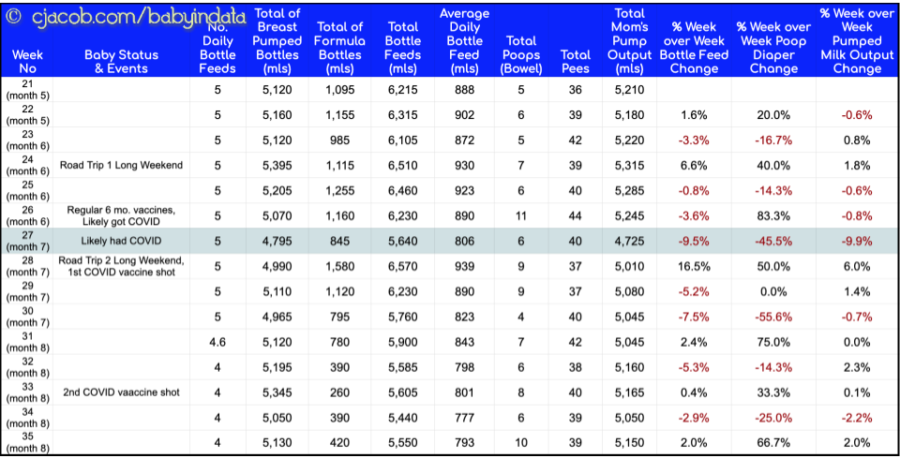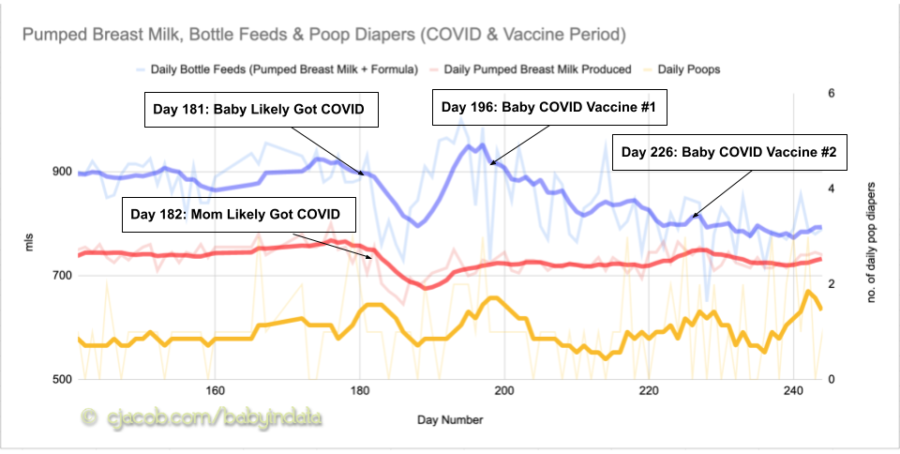There are a few big things I want to say upfront here, including my usual suggestion to read A Baby Feeding Journey over 14 Months (a 12 Part Series) to orientate you on the entire Baby’s First Year in Data series, before you continue reading the below post:
- I am not a doctor (nor a PhD), a medical scientist, a pharmacologist, or medical researcher.
- I do believe in the amazing power of vaccines to protect babies and societies at large from terrible diseases, especially over the last 100+ years.
- Our baby is on the normal U.S. CDC recommended vaccination schedule for children.
- Our baby had the COVID vaccine shortly after she reached 6 months of age.
- This is NOT a post discussing vaccine efficacy, the existence and severity of COVID, or telling you what you should do with your baby.
Now with all that out the way, let’s talk about what this post is about, which is no difference to the rest of the posts in this data series: Here we will discuss the impacts, mostly from a data perspective, on our baby when she had various shots, when she got sick, and how her illnesses may have impacted what she ate and what her diapers were like.
So our baby, who was born in December 2021, was coming into the world at a peak period of the early Omicron variant of COVID spreading across the US and around New York. This also meant that when she turned 6 months of age in June, this was very soon after the U.S. FDA finally authorized the first COVID vaccine for the 6-month to 5-year old cohort.
Of course because of the COVID era, masking, lockdowns, and other societal actions, this meant that 2022 as a whole, and 2022 into 2023, saw spikes in the seasonal cold virus, seasonal flu, RSV, Norovirus, Hand Foot and Mouth Disease, amongst many other diseases that were depressed from their usual levels in the years prior.
As we discussed in our overview and showed in all related posts, including 14 Months of Feeding a Baby in Data, our baby had the benefit of consuming (pumped/expressed) breast milk for the first 14 months of her life, which meant she was receiving antibodies and other immunity/health/nutrient benefits being produced by mom during this time (see A 1+ Year Breast Pumping Journey in Data for the breast milk pumping perspective).
So with all that said, how did our baby respond to any illness that she had, including COVID? Did vaccines make her eat less or change the amount and frequency, or her poop and pee diapers?
Table 1: Baby Feeding & Diapers + Mom Pumping (COVID Illness and Vaccine Period)

Chart 1: Baby Feeding & Diapers + Mom Pumping during COVID Illness and Vaccine Period (7-day moving average)

Some Highlights:
- I attended a work conference in early June 2022 (end of month 6 for baby), which had several thousand people in attendance, and this turned out to be a super spreader COVID event. While I never tested positive, I did have some related COVID symptoms for a few days, followed by mom having a lot of symptoms for about a week, with a clear positive test. We never tested baby, but she did run a fever for couple of days during this same period, with some flu-like symptoms. Our conclusion was baby must have had COVID, given she was also consuming pumped breast milk (peak quantities over month 6), and we weren’t practicing any form of social distancing or masking at home.
- Another thing that complicates this period a little from a data analysis perspective is that this incident was sandwiched between two road trips (baby’s first travel and nights away from home), as we talked about here in Baby Feeding on Planes & Traveling Globally Told Through Data. However, we will try and account for this and point out where this happens.
- Baby had her regular scheduled 6-month vaccines on June 10 (mid week 26), and then we suspected, based on her fever, that she got COVID (symptoms) around June 13-14 (end of week 26, day 181), which is when we started giving her infant Tylenol. She had a lot of medication June 14 (week 26) and 15 (week 27), with smaller amounts from June 16-18 (week 27).
- In week 27 (days 183 – 189), her total bottle feeds consumed dropped 9.5%, from 6,230 mls (210.5 oz) down to 5,640 mls (191 oz).
- Her poops also dropped 45.5% from 11 (week 26) to 6 (week 27), when 25% of her diapers in week 26 were poop, vs. 15% being poop in week 27.
- In week 27 (days 183 – 189), pumped/expressed milk output dropped 10% from week 26 (so similar to baby’s consumption drop). As we noted, mom definitely had COVID during this period, and we discuss A 1+ Year Breast Pumping Journey in Data further here.
- During the following week 28 (days 190 – 196), when baby seemingly fully recovered from COVID, as we assumed this based on her general temperament, behavior, and no longer running a fever, the baby’s bottle feed consumption went up 16.5%, her poop diapers were up 50%, and 24% of her diapers were poop. The feed numbers were similar(ish) to weeks 24 and 25, the last full weeks the baby was fine (to note: both weeks 24 and 28 did include 2-night road trips for travel).
- Mom’s pumped/expressed breast milk supply also went up in week 28 (days 190 – 196), but only by 6%, so not quite as fast as baby’s bottle feeding consumption change. However, mom’s COVID period seemed to last a lot longer from a symptoms perspective.
- The baby also had her first COVID vaccine shot on the last day of week 28, (day 196). Now in week 29, her bottle feed consumption did go down by 5%, but there we no change to her pooping or percentage of diapers that contained poop. During the first two days following the vaccine, we did use infant Tylenol to help mitigate fever, as well.
- It should also be noted that week 28 was baby’s all time peak feeding week from a bottle feeding perspective at 6,570 mls (222 oz), within the peak month 6. So, declines from there are inevitable.
- The baby’s second COVID shot was a month later at the early part of week 33 (day 226). We again gave her infant Tylenol on the following two days, but a lot less than following the first vaccine shot. During week 33, liquid feeds consumed were essentially flat vs. week 32 (5,605 mls vs. 5,585 mls) with a 20mls or less than an ounce difference.
When we looked at other periods when our baby had regular vaccines during month 1, then at age 2 months, 4 months, 6 months, 9 months and 12 months (we did this a month late at almost 13 months due to travel), our baby never seemed to show any outward fussiness or behavioral change, fevers, change in sleep patterns relative to that period, change in how or how much she ate, or her diapers. We never gave her any infant Tylenol following a regular vaccine schedule vaccine.
As a quick aside, let’s talk about our baby’s various pain relievers. We used four different options, but ultimately three of them had the same active ingredients being Acetaminophen and Paracetemol, which is just branded differently in various countries with brands like Tylenol in US, and Panadol/Dymadon in UK/Australia/NZ.
- Infant Tylenol (US)
- Infant Motrin (aka Ibuprofen) (US)
- Infant Genexa (US)
- Dymadon (Australia)
(*To note: Affiliate links will pay a small commission if you decide to purchase)
I will be honest: we were very angry when we realized that infant Tylenol in the U.S. contained high fructose corn syrup – HFCS (who the hell gives that to a baby…? Disappointingly, HFCS is in many mainstream formula brands in the U.S., too). Genexa brands itself as a “clean” brand in the U.S., so it doesn’t contain HFCS. However, the one medication baby actually liked the best (and funnily enough, looked forward to consuming), with no issue administering, which also did not contain any unnecessary bad ingredients, was Dymadon from Australia. She really loved the orange flavor, like she does her favorite fruits and breast milk.
In terms of other illness or fever, and certainly while teething, during this 14 month period, there were certainly times, feeds, and occasional sleeps that were not ideal. This resulted in us giving her medication to help. However, anecdotally these difficult periods seemed relatively minimal and infrequent compared to other stories we heard. So while there may have been some daily variation in a single feed or two at certain times of a day, once you look at the data trends over weeks or 7-day averages, it gets lost.
So overall while getting COVID did cause an impact to baby’s feeding and diapers, as well as mom’s expressed breast milk output, the COVID vaccines, scheduled vaccines, and other illnesses baby got had little to no impact on her eating and diaper trends.
